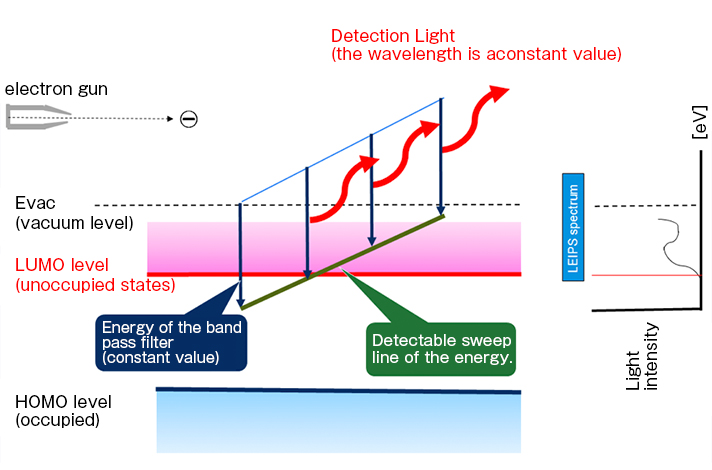

 |
 |


Introduction of LEIPS System

What is LEIPS?
By the low-energy inverse photoemission spectroscopy LEIPS (Low-Energy Inverse Photoemission Spectroscopy) newly developed by Dr. Hiroyuki Yoshida (currently
Professor of Chiba University) at Kyoto University's Chemistry Research Institute in 2012,
it is the world's first highly accurate LUMO level Measurement is now possible. We
concluded a license agreement for intellectual property with Kyoto University (Kansai TLO
Co., Ltd.) and commercialized it.





Features of LE-1 Model
With low energy of backlight electron spectroscopy, high precision LUMO level
(electron affinity) measurement was realized.
Significant reduction of sample damage
The kinetic energy of irradiated electrons is 5 eV or less, which is the damage
threshold of organic molecules.
High precision LUMO level measurement
Thin film sample of the device thickness can be measured.
Relaxation of electrons to the level related to conduction is measured directly.
Accuracy equivalent to photoelectron spectroscopy (XPS, UPS).
Energy resolution less than 0.5 eV. Reproducibility within 0.1 eV.
The measured light spectrum reflects the state density.
Easy operation of the system
Under UHV condition (10 - 8 Pa), sample transfer, pumping and measurement can be operated automatically with touch panel operation.
Efficient measurement is possible by stocking four sample substrates in buffer chamber.
Simple measurement operation
With the, automatic measurement and calculation of electron affinity can be performed with simple operation with the
Convenience Extensibility
Docking with photoelectron spectroscopy (XPS, UPS), additional deposition equipment, etc. can be handled as standard.
LE-1 is equipped as standard with a carrier box that can transfer sample substrates without exposing to the atmosphere.

Kinetic energy of irradiated electrons is set below 5 eV and near UV light is detected.
Damage avoidance of organic samples
High sensitivity photomultiplier is used.
By adopting isochromat mode, it is possible to perform spectroscopy using a dielectric multilayer bandpass filter with high sensitivity and high energy resolution.
BaO is employed as the cathode of the electron gun with high energy resolution.

LEIPS measurement configuration diagram


Item |
Conventional IPES |
LEIPS |
Electron kinetic energy |
5–15 eV |
≤ 5 eV |
Detection light wavelength |
UV light |
Near UV light(200–400nm) |
Light
detector |
filter material |
SrF2,Ca,e2 etc |
Band pass filter |
detection energy |
≥ 10eV |
–5eV |
energy resolution |
0.4–0.8eV |
–0.2eV |
sensitivity |
low |
high |
Electron gun |
cathode material |
W or others |
BaO |
energy width |
0.6–0.7 |
–0.3eV |
Resolution of system |
low 0.7–1.1eV |
high ≤ 0.5eV |
Sensitivity of system |
low |
high |
Organic sample damage |
serious |
not observed |

LEIPS(Isochromat mode)


LEIPS standard software
Simple operation
Automatic measurement of sample current spectrum and LEIPS optical spectrum simply by inputting measurement conditions and starting.
Measurement results can be processed to provide the vacuum level and electron affinity by simple operation on the calculation screen.
User friendly
Using the cursor on the calculation screen, you can directly convert the energy value at any location into the energy of electron or the energy from the vacuum level.
Measurement data is automatically saved in CSV format. It can be analyzed and used by customers.

 |
 |
 |
 |
 |
|

Inquiries by phone


Business Hours/9:00~18:00

Inquiries by mail
 |
|
|
 |
|
|
|





















